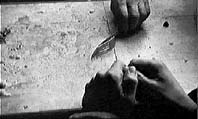
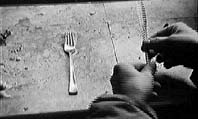
The first ten shots of Eating Out-that is, up until the intrusion of the robbers-constitute a kind of prologue, during which we are introduced both to the world of the burger joint and also to the ways in which the film tells its story.
We learn, for example, that "Parka," the lone customer who keeps his parka hood
on his head while sitting on the stool in the diner, is a man who requires
order and adherence to conventions. When the knife and fork are literally
dropped onto the counter in front of him (Shot 5), he rearranges them properly,
on either side of the spot where his plate will


soon be set down. Perhaps because the burnt french fries and non-descript vegetables are beneath his standards, he carefully pushes them away from his burger before he begins to eat it (Shots 7 and 9). And we can tell that he wouldn't dream of touching the burger with his fingers: though most people would pick it up in their hands, proprieties apparently require of him that he eat it with knife and fork (Shot 10).
At the same time, we are shown that the grill is greasy and littered with the charred remains of earlier meals (Shots 1 and 3); that the cook is unshaved and wearing a filthy undershirt, with strings of his unwashed hair hanging down from his hat (Shots 2, 4 and 7); that the windows of the diner are so caked with grease and dirt that they are completely opaque (Shot 10); and that the plate of food that is served up before our eyes is grossly unappetizing (Shots 6 and 9).
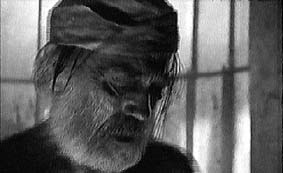
This unhygienic nightmare of a diner would be the last place in the world at which an orderly and tidy person like Parka would choose to take a meal-if the world of this film were governed by the laws of conventional logic. But we learn during these first ten shots that this world has an incongruous logic all its own, and that even though each of the characters remains consistent in basic ways, anything can happen here and nothing can be predicted.
It is, for example, totally unpredictable that the cook-at gun point!- would say to a hysterical robber demanding money: "Can't you see I'm busy? You'll have to wait until I'm finished" (Shots 12 and 13). Nor could anyone guess that the customer would calmly continue eating during the robbery; that Julie would want to eat while assisting in the hold-up; that Parka would offer a menu recommendation, and describe his No. 37 in the tone of a connoisseur (Shots 21-24); that the cook would be keenly interested in Parka's comparison of menu items no. 36 and 37 (Shot 22); that anyone could look around inside the diner and think it looked nice (Shot 32); that the cook would ask Roy "Didn't you want the money?" as the hold-up man rushes out the door (Shot 38); that Parka would, without a word, wipe Julie's nose with the sleeve of his coat, and that she would accept it (Shot 41); that he would propose that she lean up against his coat, and that she would do so (Shot 41); or that the film would end just when it does, during a moment's hesitation between two bites of food?
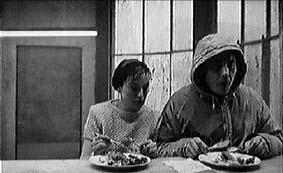 The final moment of Eating Out. |
Furthermore, the many surprises the film has in store for us are doubly satisfying, because they 1) defy our attempts to guess what will happen, catch us off guard and tickle us with their originality; and 2) at the same time, fulfill our expectation-shaped during the opening shots-of being repeatedly taken by surprise. In other words, it is by remaining unpredictable that the film lives up to what we are led to expect of it. This might be called the paradox of expected surprise.
Certain events are of course prepared in the film, almost in the way a set-up clears a path for a pay-off. For example, Parka's fussing with his knife and fork in Shot 5 prepares us for his hurriedly moving Julie's silverware closer to her when she commits what he sees as the mistake of picking up the burger in her hands (Shot 39).[1] In this respect, Parka is thoroughly consistent, though without being predictable.
There is also a useful symmetry associated with the cook's ghetto-blaster, which is knocked down by Roy at the very start of the attempted robbery (Shot 11) and placed right-side-up again by the cook when the hold-up ends (Shot 40). In this way, the radio is a marker, first of the disruption of order and subsequently of that order's reinstatement after the principal intruder makes his exit.
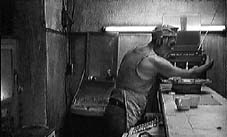 Shot 8. Cook adjusts the radio before order is disrupted. |
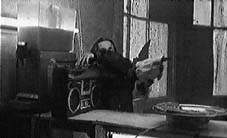
Shot 11. The principal intruder knocks the radio over. |
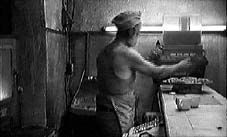 Shot 40. Cook adjusts the radio once again, marking the reinstatement of order. | |
The silverware and the radio are embedded in events which bind the fiction together. The same is true of certain constants in the film, such as the cook's striking appearance, the diner's filth, Parka's hood and quietness, Roy's hysterical voice and frightened eyes, Julie's shivering, and the theme of eating which runs through the film from start to finish.
There are both surprises and consistencies in the film-the consistencies providing structure and a framework within which the surprises are endowed with a resonance they would not otherwise have, while at the same time, the surprises, the unpredictable events and wacky behaviors, keep the structure open and breathe life into it.